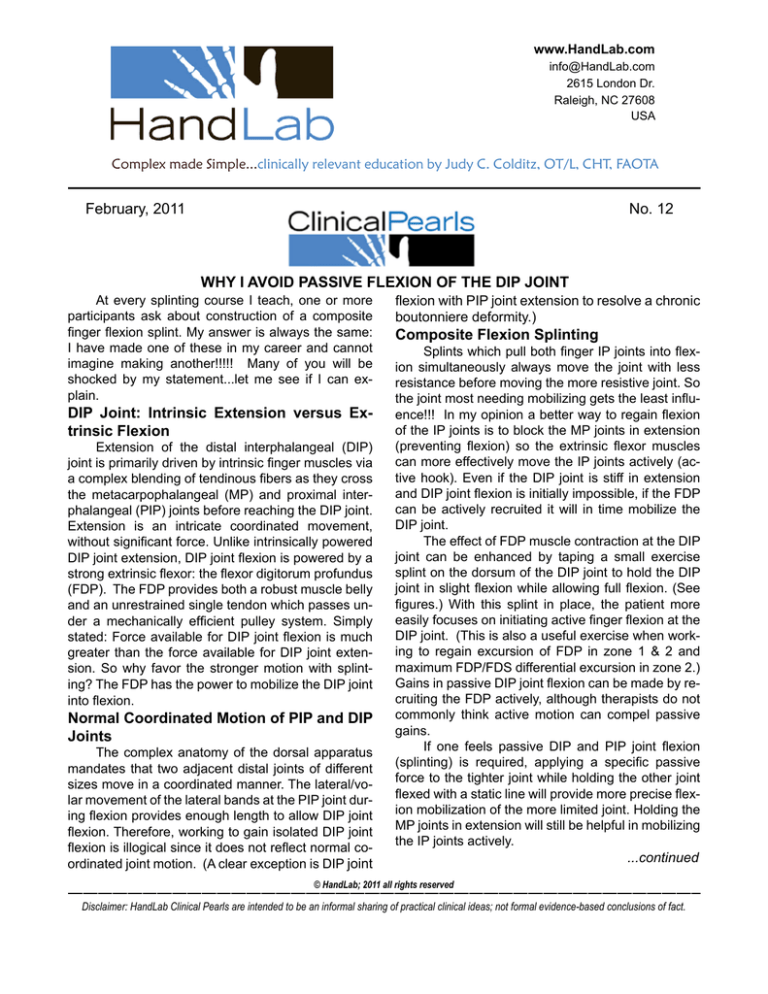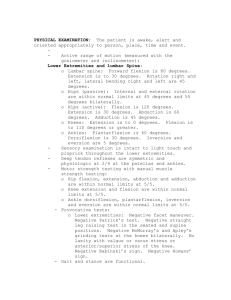
www.HandLab.com
info@HandLab.com
2615 London Dr.
Raleigh, NC 27608
USA
Complex made Simple...clinically relevant education by Judy C. Colditz, OT/L, CHT, FAOTA
February, 2011
No. 12
WHY I AVOID PASSIVE FLEXION OF THE DIP JOINT
At every splinting course I teach, one or more
participants ask about construction of a composite
finger flexion splint. My answer is always the same:
I have made one of these in my career and cannot
imagine making another!!!!! Many of you will be
shocked by my statement...let me see if I can explain.
DIP Joint: Intrinsic Extension versus Extrinsic Flexion
Extension of the distal interphalangeal (DIP)
joint is primarily driven by intrinsic finger muscles via
a complex blending of tendinous fibers as they cross
the metacarpophalangeal (MP) and proximal interphalangeal (PIP) joints before reaching the DIP joint.
Extension is an intricate coordinated movement,
without significant force. Unlike intrinsically powered
DIP joint extension, DIP joint flexion is powered by a
strong extrinsic flexor: the flexor digitorum profundus
(FDP). The FDP provides both a robust muscle belly
and an unrestrained single tendon which passes under a mechanically efficient pulley system. Simply
stated: Force available for DIP joint flexion is much
greater than the force available for DIP joint extension. So why favor the stronger motion with splinting? The FDP has the power to mobilize the DIP joint
into flexion.
Normal Coordinated Motion of PIP and DIP
Joints
The complex anatomy of the dorsal apparatus
mandates that two adjacent distal joints of different
sizes move in a coordinated manner. The lateral/volar movement of the lateral bands at the PIP joint during flexion provides enough length to allow DIP joint
flexion. Therefore, working to gain isolated DIP joint
flexion is illogical since it does not reflect normal coordinated joint motion. (A clear exception is DIP joint
flexion with PIP joint extension to resolve a chronic
boutonniere deformity.)
Composite Flexion Splinting
Splints which pull both finger IP joints into flexion simultaneously always move the joint with less
resistance before moving the more resistive joint. So
the joint most needing mobilizing gets the least influence!!! In my opinion a better way to regain flexion
of the IP joints is to block the MP joints in extension
(preventing flexion) so the extrinsic flexor muscles
can more effectively move the IP joints actively (active hook). Even if the DIP joint is stiff in extension
and DIP joint flexion is initially impossible, if the FDP
can be actively recruited it will in time mobilize the
DIP joint.
The effect of FDP muscle contraction at the DIP
joint can be enhanced by taping a small exercise
splint on the dorsum of the DIP joint to hold the DIP
joint in slight flexion while allowing full flexion. (See
figures.) With this splint in place, the patient more
easily focuses on initiating active finger flexion at the
DIP joint. (This is also a useful exercise when working to regain excursion of FDP in zone 1 & 2 and
maximum FDP/FDS differential excursion in zone 2.)
Gains in passive DIP joint flexion can be made by recruiting the FDP actively, although therapists do not
commonly think active motion can compel passive
gains.
If one feels passive DIP and PIP joint flexion
(splinting) is required, applying a specific passive
force to the tighter joint while holding the other joint
flexed with a static line will provide more precise flexion mobilization of the more limited joint. Holding the
MP joints in extension will still be helpful in mobilizing
the IP joints actively.
...continued
© HandLab; 2011 all rights reserved
Disclaimer: HandLab Clinical Pearls are intended to be an informal sharing of practical clinical ideas; not formal evidence-based conclusions of fact.
www.HandLab.com
info@HandLab.com
2615 London Dr.
Raleigh, NC 27608
USA
Complex made Simple...clinically relevant education by Judy C. Colditz, OT/L, CHT, FAOTA
February, 2011
No. 12
WHY I AVOID PASSIVE FLEXION OF THE DIP JOINT- ...continued
The Hidden Restraint: Interosseous Muscle Tightness
A small splint applied to block the DIP joint in flexion but allow further flexion encourages active flexion of that joint when the PIP joint flexes.
Any finger with limited IP joint motion easily develops adaptive shortening of the interosseous muscles (commonly called intrinsic tightness) and may
develop lumbrical muscle adaptive shortening. This
muscle tightness will continue to prevent full active
IP joint flexion even when the IP joints have regained
full passive flexion. This tightness (often subtle) must
be addressed before full finger flexion can be regained. Elongation of both the interosseous and lumbrical muscles is achieved by blocking the MP joints
in extension and encouraging active IP joint flexion
(hook fist).
Conclusion
Harnessing the power of the FDP can mobilize
the DIP joint into flexion and passive flexion/splinting
of the DIP joint is not needed. Regaining the active
hook is the best way to regain full active finger flexion, including the DIP joint.
The blocking splint encourages active DIP joint
flexion when the other DIP joints are flexing.
© HandLab; 2011 all rights reserved
Disclaimer: HandLab Clinical Pearls are intended to be an informal sharing of practical clinical ideas; not formal evidence-based conclusions of fact.


